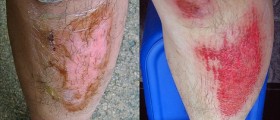
A hematoma in the leg is a localized collection of blood that pools outside the blood vessels underneath the skin, somewhere along the leg.
When a hematoma appears on a leg, it is generally because of an injury (physical trauma, like a blow or fall) to the leg, in which the skin was not broken. Such a hematoma may also occur after a surgery is performed in the area.
A leg hematoma develops as a result of blood extravasation from damaged blood vessels, meaning blood leaves the blood vessel. The blood that exits these damaged blood vessels then begins accumulating around the skin and underlying tissues, forming what can also be termed a "blood bruise".
Leg Hematoma: Clinical Characteristics
Symptoms and signs of leg hematoma basically depend on the extent as well as the severity of the causative injury. For instance, if the injury was severe enough, a leg hematoma can affect large portions of the skin, the entire area will be quite painful, and there may even be more complex damage to the underlying tissues. In less severe injuries, a leg hematoma small in size, easily recognized as a bruise, and additional symptoms such as pain are either missing or are rather mild.
Initially, extravasation of blood is associated with purple skin discoloration. As time passes, the accumulated blood disintegrates and the color of hematoma changes from green over brown to yellowish. The skin eventually regains its normal color after all by-products of the disintegration are absorbed.
Leg Hematoma: Treatment
Hematomas are usually not treated by a doctor, because the accumulated blood tends to clear on its own. If the injury is more severe and the person is in pain, the injured person is supposed to have plenty of rest and allow the injured area to heal quickly.
Pain and swelling associated with an injury are brought under control with ice packs or cold compresses. The healing process may be accelerated with hot baths. These increase circulation in the injured area and allow the accumulated blood and its by-products to be eliminated much faster.
If the patient is additionally complaining about discomfort or even pain, he/she can be prescribed some pain relieving medications (e.g. acetaminophen, ibuprofen etc.), or purchase them over the counter.
Large hematomas may require weeks or even months to be completely absorbed.
Finally, in some cases hematomas must be surgically treated. For instance, a hematoma that forms over the shinbone must be treated surgically within a short period of time. People who are not sure whether their hematoma, or what they assume to be a hematoma, requires medical attention or not are always better off erring on the side of caution by seeing a doctor.
Leg Hematoma: Complications
Large hematomas may jeopardize circulation of the injured body part. Apart from that, if a hematoma is large enough it may additionally compress nearby structures such as nerves and blood vessels. and even sometimes cause muscle damage of different degrees. All of the mentioned complications require adequate and immediate medical treatment.

















Your thoughts on this
Loading...